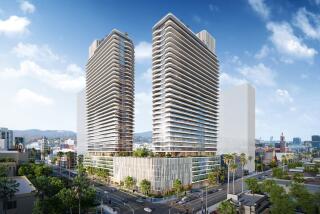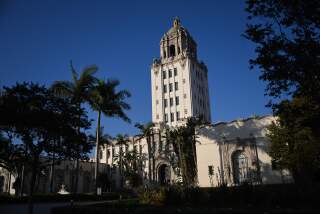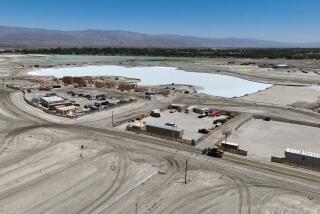Project Planned for Site by Valley
Plans for a large master-planned community in northern Los Angeles County were unveiled Friday by a builder who hopes to provide housing for 15,000 people in a transit-friendly setting.
The proposed Las Lomas development in mostly hilly terrain north of the interchange of the Golden State and Antelope Valley freeways would include 5,800 housing units, 2.3 million square feet of office, and research and development facilities, along with retail and government buildings.
Total development costs over the 20 years could reach $2billion, said developer Dan Palmer, who heads Las Lomas Land Co., a venture between his Palmer Investments Inc. of Santa Monica and Los Angeles investment group Southbrook Equities.
Palmer said he hopes the developers can join with transportation agencies to build a station that would link an internal streetcar system to Metrolink’s Antelope Valley, as well as buses operated by the Metropolitan Transportation Authority and Santa Clarita Transit.
“The model for development evolving in many circles today is the notion of smart growth that balances and integrates a mix of land uses in a self-sustaining [environment] that reduces auto dependency,” Palmer said.
But the Las Lomas proposal has raised concern among some environmentalists in the region, who fear increased traffic congestion and the loss of wilderness space.
“A lot of us would be very discouraged” if the project is eventually approved, said Lynne Plambeck, president of the Santa Clarita Organization for Planning and the Environment. “People would like to see that area kept open. You don’t want to have a lot of building in the mountains.”
*
More Homes Planned Than Ahmanson Ranch
Las Lomas would include more units than the 3,050 homes planned for the controversial and long-delayed Ahmanson Ranch development just west of the San Fernando Valley in Ventura County. It would be far smaller than another nearby proposed housing project, Newhall Ranch, which would include 21,600 units.
The property currently includes what Palmer described as a hodgepodge of uses, including various utility lines, small industrial operations and a Paintball USA park along the Old Road.
The heart of the Las Lomas plan is a series of neighborhoods carved out of the site’s hillside terrain, connected through a system of parks and trails.
Residential options would run from affordable to luxury, and plans for Las Lomas’ commercial portions include mixed-use buildings with street-level retail below both offices and residences.
Plans also call for construction of a 300-room hotel.
Portions of the site would be dedicated to such public uses as facilities for emergency services, schools, a library and child-care center.
Nearly half the property would be maintained as open space, Palmer said. Much of it would be restored to wilderness with a goal of preserving a wildlife corridor between the Santa Susana and San Gabriel mountain ranges.
Critic Plambeck also raised concerns about possible seismic activity in the area, which was rocked in 1971 by the Sylmar earthquake and also sustained extensive damage during the 1994 Northridge temblor.
“That’s the area where the freeway collapsed,” she said, referring to the sweeping Interstate 5-California 14 junction that was heavily damage in both quakes. “I would think everyone would have to look very closely at the seismological issues there.”
*
Concerns Over Effect on Freeway Traffic
Plambeck said she fears that the stretch of I-5 adjacent to the development would turn into “a parking lot for three hours every morning instead of the two hours we have now.” That stretch of the freeway already handles nearly 230,000 vehicles daily, on average, according to Caltrans.
The developers are working closely with the MTA on a plan for the Las Lomas trolley line, Palmer said, which would be linked to the community’s planned transit center. Trolley stops would typically be located no more than a five-minute walk from Las Lomas’ residential and commercial clusters.
“We looked at the site and thought it could offer great opportunities for letting people move around their community without driving,” said Roger Snoble, the transportation agency’s chief executive. “This is not the kind of density that diminishes the quality of life; it enhances it.”
The location, he said, is a logical hub to serve nearby residents and provide commuting options for others.
Construction wouldn’t being until 2004 at the earliest, Palmer said. The city of Los Angeles has begun annexation proceedings for the property, which is just north of its borders, and Palmer’s group on Friday filed an application with the city inaugurating a formal review of the proposed development.
“The key advantages of being part of the city of Los Angeles are the existence of a strong infrastructure system and guaranteed, reliable supplies of water and power,” said Palmer, who has developed apartments and condominiums in the San Fernando and Santa Clarita valleys. He is related to Geoff Palmer, a developer of luxury apartment projects in downtown Los Angeles.
Palmer said the approval process is bound to be a challenge, as is usually the case with large California developments.
The property isn’t home to endangered species, Palmer said, and doesn’t appear to be plagued with environmental contaminants.
Las Lomas wouldn’t significantly improve the state’s housing shortage. Analysts estimate that builders are producing 55,000 to 100,000 fewer units than what is needed to absorb annual growth in California.
*
Times staff writer Karen Robinson-Jacobs contributed to this report.
More to Read
Sign up for Essential California
The most important California stories and recommendations in your inbox every morning.
You may occasionally receive promotional content from the Los Angeles Times.






